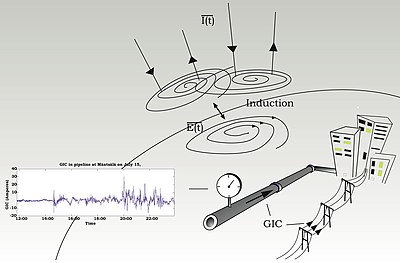|
|
Post by missasip on Dec 30, 2013 10:08:33 GMT -7
Well guess need the experts to step in on this subject matter a bit.
Been reading elsewhere that equipment an EMP might get, a CME won't bother. Is this true? Not that it really makes all that much difference I guess, but the question still stands.
Seems there is a difference in the E charges and other charges that make the difference.
Thanks in advance.
Jimmy
|
|
|
|
Post by Cwi555 on Dec 30, 2013 11:16:43 GMT -7
I've covered that in the past. A CME is ground up, an EMP is both air down, and ground up.  That's the basic idea behind ground induced current. Something sparkies should be well used to dealing with, as well as pipeliners etc. Telluric currents (read earth currents), flow naturally through the earth and seas every moment of the day and night. They are diurnal in nature, being that they flow towards the equator on the sun side, and back towards the poles on the night side. Typically the current created by modern electric systems is stronger than telluric currents, thus they ground, and some say are absorbed by the natural currents. However, during a CME induced GIC event, they can effectively reverse polarity, your ground becomes a positive and things that are grounded start frying. An EMP device comes in two main flavors. One is a local area, the other invariably will be a HEMP device. the former only induces an E1, and E2 field, the latter induces an E1, E2, E3, and E3 heave field. Rise times for the first two vary by milliseconds to several seconds. E3 can go upwards of 10 seconds, while the E3 heave component can go upwards of 2 minutes. The E1 and E2 are top down only, I.E. they come from the air only. E3 and E3 heave pump up the natural telluric currents creating GIC that works in the same way a solar induced, or stellar induced event would. The heave component is created by blowing a microsecond hole in the earths magnetosphere. Since magnetic field lines cannot cross, they flux into the earth in the same manner as depicted above. The 1962 K3 test by the Soviets in Kazakhstan induced amperage exceeding 3,400 amps in the phone lines, and the same for pipelines before the instruments fried. The only real defense is a floating ground faraday cage. You don't see cars dragging a ground around, yet they work, the same for planes. It's the only option available that is known to have worked. As for experts, you know my opinion on that. |
|
|
|
Post by missasip on Dec 30, 2013 12:31:18 GMT -7
So what is the floating ground in cars and planes? The wheels turning and the turbines turning?
I know you have covered this a bunch in the past and thank you for going back over it.
So the "gang tool box" we spoke of before would or should cover both scenarios?
Thanks in advance.
Jimmy
|
|
|
|
Post by Cwi555 on Dec 30, 2013 13:22:43 GMT -7
So what is the floating ground in cars and planes? The wheels turning and the turbines turning? I know you have covered this a bunch in the past and thank you for going back over it. So the "gang tool box" we spoke of before would or should cover both scenarios? Thanks in advance. Jimmy Floating ground- A reference ground that is not earthed. A reference point or voltage in a circuit that is not tied to an actual external ground: "modern dictionary of electronics" 7th ed. page 292 That is the 'official' definition. Cars, planes, hand held devices, and everything else not plugged in to a ground meet that definition. Without that, connection, and as long as the device is not lying on the ground, It's unlikely for it to be affected by any solar event/geomagnetic storm. Passive electrical elements such as resistors, capacitors, inductors, etc, are usually the only thing threatened by solar events, as they are typically ground. When it comes to active circuits such as found in electronics, it's another beast. Those are the elements that typically exist in floating ground systems as mentioned. They are subject to the E1, and E2 components of an EMP. One of the keys to solid state electronics is the P-N junction. When p-type and n-type materials are placed in contact with each other, the junction behaves very differently than either type of material alone. Specifically, current will flow readily in one direction (forward biased) but not in the other (reverse biased), creating the basic diode (Read solar cell, LED, etc). For this protection, an inner and outlayer with a non conductive material between them is required. They cannot have any gaps in the faraday cage either. Remember that in the E1 component especially, the wavelength for the sin waves of projected energy will get below .005". Since the smallest hole a sin wave (radio wave for instance) can travel through is half it's wavelength, it doest take much to realize there can be no gaps contrary to the opinion of 'internet experts'. |
|
|
|
Post by missasip on Dec 31, 2013 9:04:42 GMT -7
Any chance this thread can be added to the sticky one about emp in the BOV forum. I should have put this there anyway.
I think it's a subject we should all discuss from time to time.
Thanks
Jimmy
|
|
|
|
Post by Cwi555 on Dec 31, 2013 9:57:59 GMT -7
Any chance this thread can be added to the sticky one about emp in the BOV forum. I should have put this there anyway. I think it's a subject we should all discuss from time to time. Thanks Jimmy I'll leave that up to CCM/crash/CGU since I am an active participant in this one. If they think it wise, we'll sticky it. |
|